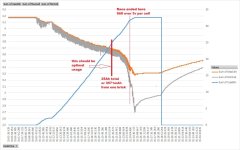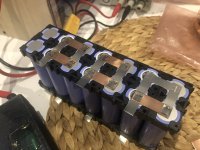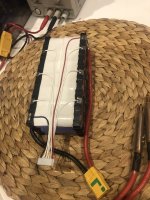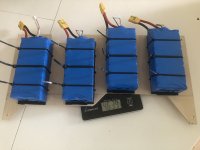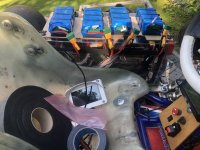You are using an out of date browser. It may not display this or other websites correctly.
You should upgrade or use an alternative browser.
You should upgrade or use an alternative browser.
30Ah 28s LiPo from 7s bricks
- Thread starter nuxland
- Start date
hallkbrdz
100 W
Thanks for asking, I've been looking at the Zeva BMS as well so had similar thoughts...
As I understand it... I'll need a master BMS and a couple slaves to monitor the pack (once I decide what cells / bricks to use) when running. Those will need to talk to the motor controller and something overall to let me see the health (temperature, total voltage) of the pack, and the temperature of the motor and possibly controller with attention getting lights / buzzer to warn me when getting critical and/or to just shut it down. The BMS will also need to talk to the charger (when hooked up) to stop it from over-charging and to slowly balance the pack differences when I have time at home. Plus something to record all the data that will put up with the extreme kart vibrations. And of course it all needs to be waterproof (non immersible of course).
Oh and either a large charge battery pack or a gas generator to power the charger at the track (AC plugs are basically non-existent).
That complete engine / dash / harness swap from a MK4 VW I did into my Corrado was a cakewalk to everything I'm having to learn to do this. I've been looking into this seriously for a little more than a year and still feel ignorant since most how-to-build an EV topics are geared towards cruising and not pushing components in racing.
As I understand it... I'll need a master BMS and a couple slaves to monitor the pack (once I decide what cells / bricks to use) when running. Those will need to talk to the motor controller and something overall to let me see the health (temperature, total voltage) of the pack, and the temperature of the motor and possibly controller with attention getting lights / buzzer to warn me when getting critical and/or to just shut it down. The BMS will also need to talk to the charger (when hooked up) to stop it from over-charging and to slowly balance the pack differences when I have time at home. Plus something to record all the data that will put up with the extreme kart vibrations. And of course it all needs to be waterproof (non immersible of course).
Oh and either a large charge battery pack or a gas generator to power the charger at the track (AC plugs are basically non-existent).
That complete engine / dash / harness swap from a MK4 VW I did into my Corrado was a cakewalk to everything I'm having to learn to do this. I've been looking into this seriously for a little more than a year and still feel ignorant since most how-to-build an EV topics are geared towards cruising and not pushing components in racing.
hallkbrdz
100 W
Yes, I saw that. No mention if it is water resistant (IP65) or can be read in direct sunlight though. It would be the best for what I really need, and is inexpensive, but I may have to coat the circuit board for water protection and shield it somehow so it can be read.
I've also looked that the AEM Carbon displays. Their loggers are separate: https://www.aemelectronics.com/products/cd-digital-dash-displays-adapter-harnesses/CD-5-Carbon-Digital-Racing-Dash-Displays
And of course AIM has a very nice dash and logger: https://www.aim-sportline.com/en/products/mxs-1.2/index.htm
I've also looked that the AEM Carbon displays. Their loggers are separate: https://www.aemelectronics.com/products/cd-digital-dash-displays-adapter-harnesses/CD-5-Carbon-Digital-Racing-Dash-Displays
And of course AIM has a very nice dash and logger: https://www.aim-sportline.com/en/products/mxs-1.2/index.htm
Actually when racing I do not have time to look at my tablet at all. I have cycle analyst in my wheel and in straights i can see how many Ah I have used, but thats also not important anymore, because I know how many Ah i'm using per lap.
I have low voltage cutoff configured in sevcon and that is enough because i will never run my batterys empty. So there is very little possiblility that one cell will go very low.
Inside each battery I have dc/dc for 12V and 3pcs of zevas and olimex with 4 line lcd where i can see lowest/highest volt and temperature.
Olimex is also recording canbus data (battery voltages, and sevcon data) but i'm not using these because using my windows program log i multiple times easier Olimex is also capable of controling my elcon canbus charger and as i have in each battery charge port i can let one pack for charging when racing with another one.
Olimex is also capable of controling my elcon canbus charger and as i have in each battery charge port i can let one pack for charging when racing with another one.
In allmoust all Estonian kart tracks have 32A three phase power outlet that is ususally always not used. There is also regular 220V ones that gas karts are using with long extension cords. But i have made a three phase to 3x 220V extension cord for myself that i can use for charging my battery on site.
Usually i do not want to race with rain, but have raced with very light rain or wet tracks. My batterys are sealed for splashes but for heavy rain i do not want to use them. Also i have my motor air cooled (forced centrifugal fans) so that also do not like rain
As for vibration, right now all components are still working ok.
I have low voltage cutoff configured in sevcon and that is enough because i will never run my batterys empty. So there is very little possiblility that one cell will go very low.
Inside each battery I have dc/dc for 12V and 3pcs of zevas and olimex with 4 line lcd where i can see lowest/highest volt and temperature.
Olimex is also recording canbus data (battery voltages, and sevcon data) but i'm not using these because using my windows program log i multiple times easier
In allmoust all Estonian kart tracks have 32A three phase power outlet that is ususally always not used. There is also regular 220V ones that gas karts are using with long extension cords. But i have made a three phase to 3x 220V extension cord for myself that i can use for charging my battery on site.
Usually i do not want to race with rain, but have raced with very light rain or wet tracks. My batterys are sealed for splashes but for heavy rain i do not want to use them. Also i have my motor air cooled (forced centrifugal fans) so that also do not like rain
As for vibration, right now all components are still working ok.
Tested lipo pack in kart track. Was not regular race but special event, only 3 laps + tire warmer lap.
But it seems that voltage drop was very minimal. 558A was max i got on that track (because of the obstacles) and with that voltage was 103,43V. At beginning of the race voltage was 114,51v but max amps was already at third lap so voltage drop was less than 10v.
And it seems that it accelerated also better with lipo than my small lifepo4 because of that little voltage drop.
Lipo battery practice.
https://youtu.be/-JImaewEbJo
But it seems that voltage drop was very minimal. 558A was max i got on that track (because of the obstacles) and with that voltage was 103,43V. At beginning of the race voltage was 114,51v but max amps was already at third lap so voltage drop was less than 10v.
And it seems that it accelerated also better with lipo than my small lifepo4 because of that little voltage drop.
Lipo battery practice.
https://youtu.be/-JImaewEbJo
I used in practice 5,37Ah and in 1st race 6,44Ah, so together 11,81Ah. Battery should be 35Ah but when I tested one brick with 70A then usable was around 3,6Ah, that makes usable in whole battery 25,2Ah 
And as cell voltage after 1st race were around 3,81v i tought that i let lipo be in storage voltage and use my lifepo4 packs in 2nd and 3rd race.
After 1st race whole pack voltage was 106,75v and before practice it was 115,19v. So 8,44v drop in 11,81 used Ah, that makes 0,715v drop with each Ah. And if we go from here then 25,2Ah usable is around 18v drop. So if I would used only my lipo in all races it would had 97V in resting, that makes 3,47v in cell level and considered 0% and empty. So voltage drop is not linear it seems.
I have to test it in kart track and make 10+2 laps in first try and see can i use it more that 10 laps race.
And as cell voltage after 1st race were around 3,81v i tought that i let lipo be in storage voltage and use my lifepo4 packs in 2nd and 3rd race.
After 1st race whole pack voltage was 106,75v and before practice it was 115,19v. So 8,44v drop in 11,81 used Ah, that makes 0,715v drop with each Ah. And if we go from here then 25,2Ah usable is around 18v drop. So if I would used only my lipo in all races it would had 97V in resting, that makes 3,47v in cell level and considered 0% and empty. So voltage drop is not linear it seems.
I have to test it in kart track and make 10+2 laps in first try and see can i use it more that 10 laps race.
hallkbrdz
100 W
Ouch.
I had estimated (based on other tests of similar Lipo packs of that brand I found online) that the real capacity of those "5000mAh" bricks would be roughly 4500mAh under load. But 3600mAh, that really hurts at only 72% of advertised rating. At least now I've been able to update the spreadsheet and adjust the calculations some to be more accurate.
So now it shows for my wimpy 100cc TAG final I'd need 4S8P (29.1kg) of those bricks.
I'm just jumping to test out the Zero NMC cells (Farasis / A123) to see how they handle the load. I'll try it with the full 7.2kWh pack first (heavy but easy), although I'll need to get something like you have on order to record the internal pack BMS outputs.
I had estimated (based on other tests of similar Lipo packs of that brand I found online) that the real capacity of those "5000mAh" bricks would be roughly 4500mAh under load. But 3600mAh, that really hurts at only 72% of advertised rating. At least now I've been able to update the spreadsheet and adjust the calculations some to be more accurate.
So now it shows for my wimpy 100cc TAG final I'd need 4S8P (29.1kg) of those bricks.
I'm just jumping to test out the Zero NMC cells (Farasis / A123) to see how they handle the load. I'll try it with the full 7.2kWh pack first (heavy but easy), although I'll need to get something like you have on order to record the internal pack BMS outputs.
Note that just because capacity at crazy high C-rates is much lower than rating, does not imply dishonest labeling, that might just be Peukert's Law in action.
Take a brand new pack, and do a precisely controlled timed CC load test at say 0.05C, if you get within 90-95% of rating, that's just how the industry rolls. . .
Take a brand new pack, and do a precisely controlled timed CC load test at say 0.05C, if you get within 90-95% of rating, that's just how the industry rolls. . .
hallkbrdz
100 W
For non hobby cells the capacity rating discharge usually seems to be 0.5C, and that's slightly conservative. Plus the large manufactures publish their own discharge charts showing various loads, something that LiPo pack companies don't seem to do. So I based what before I had on 3rd party tests.
A 0.5C discharge is not how we use these cells of course, so without testing data that matches our use case the best available test data is from those constant load charts. From that we can see the true starting voltage and capacity down to the voltage we want to stop at. Unfortunately the straight load discharge graphs don't seem to provide similar overall results from stretched out pulsed discharge loads. This seems to be a characteristic of at least this battery's LiPo chemistry. So with this information I think it is reasonable to make adjustments to set the expectations for similar products based on this type of cell. As more information becomes available this can of course be refined upward, or downward to closer match real results.
A 0.5C discharge is not how we use these cells of course, so without testing data that matches our use case the best available test data is from those constant load charts. From that we can see the true starting voltage and capacity down to the voltage we want to stop at. Unfortunately the straight load discharge graphs don't seem to provide similar overall results from stretched out pulsed discharge loads. This seems to be a characteristic of at least this battery's LiPo chemistry. So with this information I think it is reasonable to make adjustments to set the expectations for similar products based on this type of cell. As more information becomes available this can of course be refined upward, or downward to closer match real results.
January 2019 I tested one of my 7s 5Ah brick with 70A
As you can see that after 3 minutes my duo 4010 stopped discharge because of cell voltage went under 3,5v under load.
I must admit that it was not charged to 4,2v but to 4,1v so there can be a little bit more inside
And as I said earlier I got 3600mAh out from the 5000mAh brick
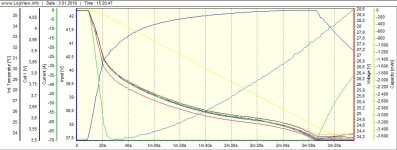
So one thing for sure is that I need to just run laps in the kart track to see how many i can get.
As i have remote live information available then it can be done with two people (one racing and another monitoring and speaking to the driver what parameters are).
Just have to find time to actually do it
As you can see that after 3 minutes my duo 4010 stopped discharge because of cell voltage went under 3,5v under load.
I must admit that it was not charged to 4,2v but to 4,1v so there can be a little bit more inside
And as I said earlier I got 3600mAh out from the 5000mAh brick

So one thing for sure is that I need to just run laps in the kart track to see how many i can get.
As i have remote live information available then it can be done with two people (one racing and another monitoring and speaking to the driver what parameters are).
Just have to find time to actually do it
Even my lipos that should be very high C rated warmed up a lot after 14 laps of racing.
I have 7 of 5Ah packs in parallel so 35Ah in total and used ~32Ah from them during the race.
Temp sensors are between bricks so measuring outside temperature of 5Ah turningy heavy 7s brick.
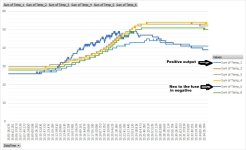
So I could imagine how 14x 21700 molicell in parallel (10C each = ~600A) will be event more hot after that race.
And this is the reason I did not went to 21700 (event I could get 56Ah bruto and around 45Ah usable)
I have 7 of 5Ah packs in parallel so 35Ah in total and used ~32Ah from them during the race.
Temp sensors are between bricks so measuring outside temperature of 5Ah turningy heavy 7s brick.

So I could imagine how 14x 21700 molicell in parallel (10C each = ~600A) will be event more hot after that race.
And this is the reason I did not went to 21700 (event I could get 56Ah bruto and around 45Ah usable)
Concluded that 7pcs in paraleel (35Ah) is not enough for 14 laps, so will add one more in parallel.
But there is a problem, hobbyking does not have my 7s 5Ah Turningy heavy or in warehouse and ETA is september
So instead bought 56 pcs of 4Ah samsung 21700 and will build 4 pcs of 7s2p units instead.
I do not have monitoring during racing in these new addons (neither will they connected to lipo pack bms), they will be 8Ah and are in parallel with 5Ah lipo units. So they can't be run empty, only consern is that they will be to hot and not from the acceleration but between acceleration they will give energy back to lipo because they did not contribute to acceleration that much (have higher internal resistance). But I'm not very conserned as 2p will result in 70A so called continious and with ~35-40kw at 100v its ~400A devided by 8 will do 50A and even less because of higher resistance.
They should work and give me 2 more laps (actually lipos will not be so empty after 14 laps as without them)
But lets see, 21700 will arrive soon, and I can do a test.
BTW. I will charge these 21700 7s2p units separately from the lipo pack. Using my 4010duo icharger (2pcs of 7s units in one output and 2pcs of 7s units in second output) charging with 6A (can do faster if needed) should be at the same speed as charging my lipo 28s with 23A.
But there is a problem, hobbyking does not have my 7s 5Ah Turningy heavy or in warehouse and ETA is september
So instead bought 56 pcs of 4Ah samsung 21700 and will build 4 pcs of 7s2p units instead.
I do not have monitoring during racing in these new addons (neither will they connected to lipo pack bms), they will be 8Ah and are in parallel with 5Ah lipo units. So they can't be run empty, only consern is that they will be to hot and not from the acceleration but between acceleration they will give energy back to lipo because they did not contribute to acceleration that much (have higher internal resistance). But I'm not very conserned as 2p will result in 70A so called continious and with ~35-40kw at 100v its ~400A devided by 8 will do 50A and even less because of higher resistance.
They should work and give me 2 more laps (actually lipos will not be so empty after 14 laps as without them)
But lets see, 21700 will arrive soon, and I can do a test.
BTW. I will charge these 21700 7s2p units separately from the lipo pack. Using my 4010duo icharger (2pcs of 7s units in one output and 2pcs of 7s units in second output) charging with 6A (can do faster if needed) should be at the same speed as charging my lipo 28s with 23A.
And real word test confirms that 3600mAh per brick is optimal usage if you want that your lipos last also.nuxland said:January 2019 I tested one of my 7s 5Ah brick with 70A
As you can see that after 3 minutes my duo 4010 stopped discharge because of cell voltage went under 3,5v under load.
I must admit that it was not charged to 4,2v but to 4,1v so there can be a little bit more inside
And as I said earlier I got 3600mAh out from the 5000mAh brick
In this graph I actually used 4400mAh per brick in race and it was too much. in cooldown lap voltages went below normal.
Attachments
Test went great and everything works as I thought it will work.
This extension gave me 2 more laps.
[youtube]1Q1KalURGqw[/youtube]
So charged lipos to ful 4,2v and 32,317Ah went in with 15A charging. That is around 4,616Ah per one brick (5Ah should be bruto).
Also charged 21700 to 4,2v and result was A=6,104Ah ja B=6,368Ah ja C=5,961Ah ja D=6,261Ah. So average 1500mAh was taken more from 21700 than from lipo bricks. And actually 21700 is bigger capacity (8Ah) and therefore gave energy back to lipos.
After charging to full I connected 21700 addon's to main pack and discharged with my 3kw resistor bank back to 3,850v.
Lipo discharge curve is a little bit different than liion's. I'm discharging with 25A so devide by 8 should be 3,125A per lipo brick and from 21700 addon.
But at first only 1,85A was taken from 21700, then after discharging 2,6Ah around 2,66A was taken from 21700. At 6,6Ah 5,82A then at 7,6Ah 6,46A.
At 8,9Ah 5,86A and at 14,88Ah it stabilised to 3,21A so evenly distributed among lipo bricks and 21700 addon.
Then I disconnected the load but still around 1,82A went from 21700 to lipos. It's simple there was voltage rise in 21700 but allmost none in lipos do the load going away.
[youtube]Hi_CRqTg9ug[/youtube]
This extension gave me 2 more laps.
[youtube]1Q1KalURGqw[/youtube]
So charged lipos to ful 4,2v and 32,317Ah went in with 15A charging. That is around 4,616Ah per one brick (5Ah should be bruto).
Also charged 21700 to 4,2v and result was A=6,104Ah ja B=6,368Ah ja C=5,961Ah ja D=6,261Ah. So average 1500mAh was taken more from 21700 than from lipo bricks. And actually 21700 is bigger capacity (8Ah) and therefore gave energy back to lipos.
After charging to full I connected 21700 addon's to main pack and discharged with my 3kw resistor bank back to 3,850v.
Lipo discharge curve is a little bit different than liion's. I'm discharging with 25A so devide by 8 should be 3,125A per lipo brick and from 21700 addon.
But at first only 1,85A was taken from 21700, then after discharging 2,6Ah around 2,66A was taken from 21700. At 6,6Ah 5,82A then at 7,6Ah 6,46A.
At 8,9Ah 5,86A and at 14,88Ah it stabilised to 3,21A so evenly distributed among lipo bricks and 21700 addon.
Then I disconnected the load but still around 1,82A went from 21700 to lipos. It's simple there was voltage rise in 21700 but allmost none in lipos do the load going away.
[youtube]Hi_CRqTg9ug[/youtube]


